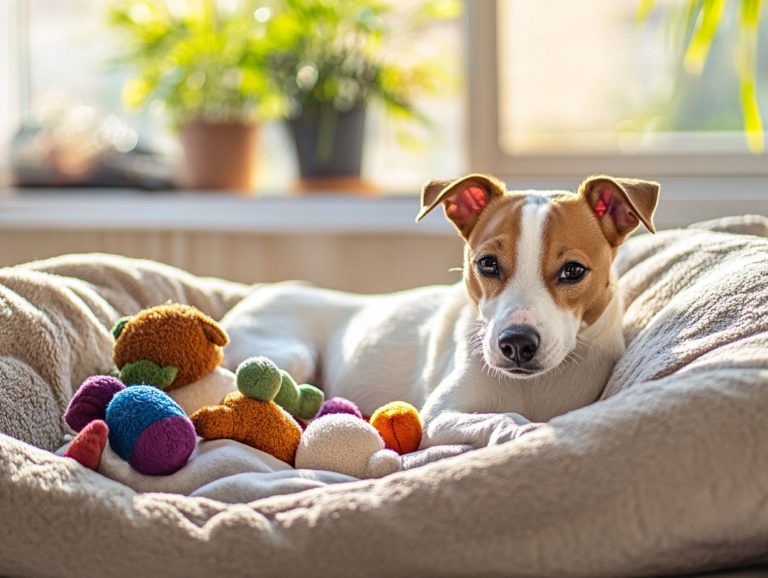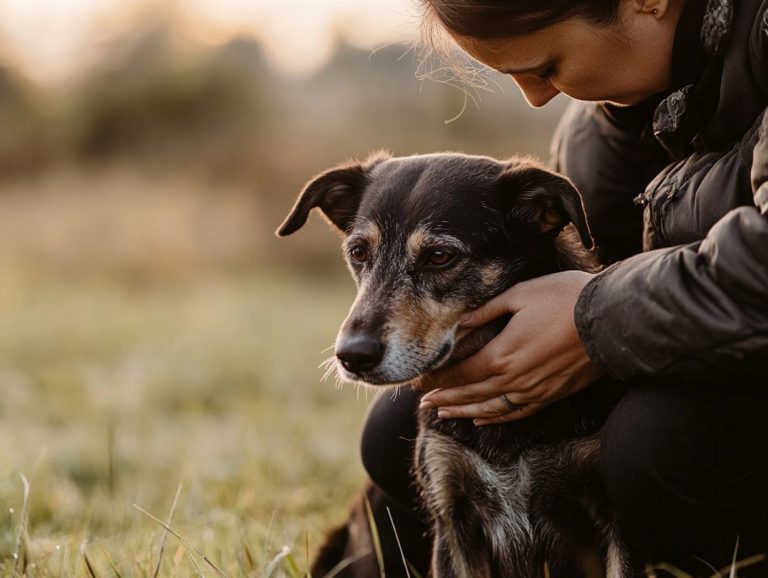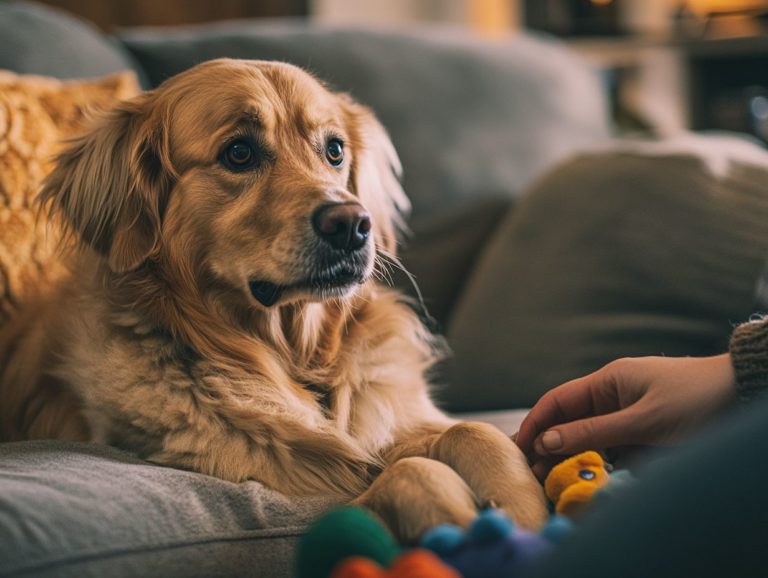Signs Your Pet Needs Help With Anxiety
Many pet owners may not realize that their furry companions can experience anxiety just like humans do. Understanding the causes and signs of pet anxiety is crucial for their overall well-being.
This article explores the common triggers of anxiety in pets. It highlights the behavioral changes to watch for and offers practical strategies to create a calming environment. It also discusses when to seek professional help and provides tips for preventing anxiety from developing in the first place.
Your pet deserves a happy, stress-free life. This information is designed to guide you in achieving just that.
Contents
Key Takeaways:

- Watch for changes in your pet’s behavior, like excessive grooming or hiding. These can signal anxiety.
- Create a calm environment for your pet. A quiet space and soothing activities like massage can help.
- Seek professional help if anxiety disrupts your pet’s daily life. A vet can offer guidance and treatment options.
Understanding Pet Anxiety
Understanding pet anxiety is vital for you as a dog owner. It can show up in different ways, including separation anxiety, fear-related anxiety, and confusion related to aging in pets.
Recognizing the root causes and symptoms of anxiety in your dog is key to crafting an effective treatment plan. This plan should include methods to change your pet’s behavior for the better, mental stimulation, and physical exercise. By learning to interpret canine body language, you can create a more supportive environment for your anxious dog, leading to better behavior and improved well-being.
What Causes Anxiety in Pets?
Various factors contribute to anxiety in your pets, including separation anxiety, fears, phobias, and confusion related to aging in pets. If left unaddressed, these issues can lead to significant behavioral problems that need attention from you and a veterinarian.
Understanding the underlying causes of this distress is crucial. Environmental factors, such as loud noises or changes in the household, can easily trigger anxiety in sensitive animals. Previous traumas whether from past abuse or startling events can leave lasting emotional scars. Genetic predispositions may also impact anxiety levels, with certain breeds exhibiting higher anxiety levels.
Veterinarians suggest that nearly 20% of pets show symptoms of anxiety, underscoring the importance of recognizing and addressing these issues promptly. For pet owners, knowing the signs you’ve found the right pet anxiety expert is crucial. Adopting a proactive approach can significantly enhance your pet’s quality of life.
Signs of Anxiety in Pets
Recognizing the signs of anxiety in your pets is essential for intervening before behavioral issues spiral out of control, and knowing when to consult a professional for pet anxiety can make a significant difference.
Common symptoms of anxiety in dogs can manifest in various ways, such as:
- urinating in the house
- engaging in destructive behavior
- excessive barking
These behaviors often signal distress. Understanding your dog’s body language can provide valuable insights into their emotional state.
Behavioral Changes to Look Out For

Behavioral changes in dogs often act as red flags for anxiety. Symptoms like excessive barking, destructive behavior, and even indoor urination can point to underlying emotional distress.
As a pet owner, you should be particularly attentive to signs such as pacing, clinginess, or sudden aggression. These behaviors can highlight your dog’s emotional struggles. Understanding the needs of anxious pets can help you address their heightened anxiety, which may manifest in your pup’s reluctance to engage in activities they once loved or even changes in their appetite.
Recognizing these indicators is vital, as they may call for tailored interventions. If anxiety lingers or escalates, reaching out to a professional dog trainer or veterinarian is essential. They can offer specialized insights and recommend effective strategies, including understanding anxious behaviors in pets, for managing anxiety in your beloved pet.
How to Help Your Anxious Pet
Helping your anxious pet requires an overall plan. Start by crafting a calming environment that soothes their nerves.
Implement a treatment plan that addresses their unique needs. Effective training strategies can support their journey and cater to their temperament.
Enhance their well-being with mental stimulation and regular exercise. This creates a balanced routine that promotes relaxation and happiness.
Creating a Safe and Calm Environment
A safe and calm environment is essential for your anxious dog. It reduces stress and fosters a sense of security.
Establish a designated safe zone in your home. This offers your dog a retreat from overwhelming situations.
Consider a snug crate or a quiet corner with familiar blankets and toys. This gives them a cozy spot to relax.
Play soft, calming music to mask loud noises. This helps create a soothing atmosphere that enhances their tranquility.
Make sure their resting areas are cozy and inviting. Your pet will love it!
By applying these techniques consistently, you nurture their emotional well-being. This helps your furry companion feel safe and cherished.
Training and Behavioral Techniques
Training and behavioral techniques are vital for tackling your dog’s anxiety. This includes getting them used to things that scare them and gradually exposing them to anxiety-inducing situations.
Use treats and praise to create a rewarding atmosphere during these exposures. Incorporate play areas or obstacle courses for distraction and mental stimulation.
Working with a professional dog trainer can enhance these strategies. They can tailor a plan that meets your dog’s specific needs.
Many pet owners have seen remarkable transformations. With patience and dedication, significant improvements in behavior are within reach!
When to Seek Professional Help

Knowing when to seek professional help for your pet’s anxiety is essential. If you notice severe anxiety symptoms, it’s important to understand the dangers of ignoring pet anxiety and consult a veterinarian.
This ensures your beloved companion gets the care they deserve.
Identifying Severe Anxiety and When to Consult a Vet
Identifying severe anxiety can be challenging, but it’s crucial. Consult a vet if anxiety medications or a diagnosis might be necessary.
Look for signs that hint at deeper issues. Excessive barking, destructive behaviors, trembling, or withdrawal from social interactions are red flags. If you notice these symptoms, it’s important to know what to do if your pet develops anxiety suddenly.
If your dog shows these behaviors during stressful events like thunderstorms, seek help without delay.
Early intervention leads to effective management strategies that enhance emotional well-being.
Stay vigilant about these behaviors. It s vital for nurturing your beloved companion s emotional health.
Preventing Anxiety in Pets
Preventing anxiety requires a proactive approach. Focus on minimizing stress and addressing underlying causes of anxiety disorders.
Provide mental stimulation, engage in regular exercise, and implement effective training strategies. This creates a serene environment for your furry friends.
Tips for Reducing Stress and Anxiety in Pets
Implementing effective strategies to reduce stress and anxiety in your pets is essential for their overall well-being. This involves a thoughtful combination of calming techniques, keeping your pet’s mind active, and regular physical exercise.
By creating an environment where your pets feel secure and engaged, you can make significant strides in alleviating their discomfort. Recognizing that different animals may respond uniquely to various approaches allows you to tailor solutions specifically for them.
For example, setting up a cozy safe space with comforting blankets and toys can serve as a sanctuary for anxious pets. You can also incorporate interactive toys or puzzle feeders, which are toys that challenge your pet to work for their food, providing mental challenges that distract them from anxiety triggers.
Equally important is maintaining a consistent daily routine. Pets thrive on predictability and structure, which can greatly reduce their stress levels. You might also consider natural supplements or calming products to offer extra support when needed, helping your furry friends find their calm amidst the chaos.
Frequently Asked Questions

What are the signs that my pet needs help with anxiety?
Some common signs that your pet may be struggling with anxiety include excessive barking or meowing, destructive behavior, changes in appetite, hiding or avoiding interactions, and excessive grooming or licking. To better understand what to watch for, refer to the signs of chronic anxiety in pets. Keep an eye out for any abnormal behavior and consult with your veterinarian if you have concerns.
How can I tell if my pet is experiencing separation anxiety?
If your pet becomes anxious or stressed when you leave the house or are away for extended periods, they may be experiencing separation anxiety. Signs include excessive vocalization, pacing or restlessness, destructive behavior, and going to the bathroom indoors. To help manage this issue, consider understanding anxiety triggers in pets, as it’s important to address separation anxiety to ensure your pet’s well-being.
Can changes in my pet’s routine or environment cause anxiety?
Yes, changes in routine or environment can easily trigger anxiety in pets. This includes a new living situation, new family members or pets, or even changes in your own behavior. Try to maintain a consistent routine and provide a safe and familiar environment for your pet to help ease any anxiety they may be experiencing.
Are certain breeds more prone to anxiety?
Yes, some breeds are more prone to anxiety than others. For example, small dogs, herding breeds, and working breeds may be more susceptible due to their high energy and alertness. However, every pet is unique and can develop anxiety regardless of their breed.
What can I do to help my pet with anxiety?
There are several things you can do to help your pet manage their anxiety. This may include providing a safe and comfortable environment, using calming aids such as pheromone diffusers or supplements, engaging in regular exercise and keeping their mind active, and seeking professional help from a veterinarian or animal behaviorist.
Is medication necessary for treating my pet’s anxiety?
Medication may be necessary in severe cases of anxiety, but it is not always the first line of treatment. It’s important to work with your veterinarian to determine the best course of action for your pet’s specific needs. In many cases, a combination of behavioral modification techniques and natural calming aids may suffice to help your pet manage their anxiety.
What strategies have you found effective for your pet’s anxiety? Share your experiences!






